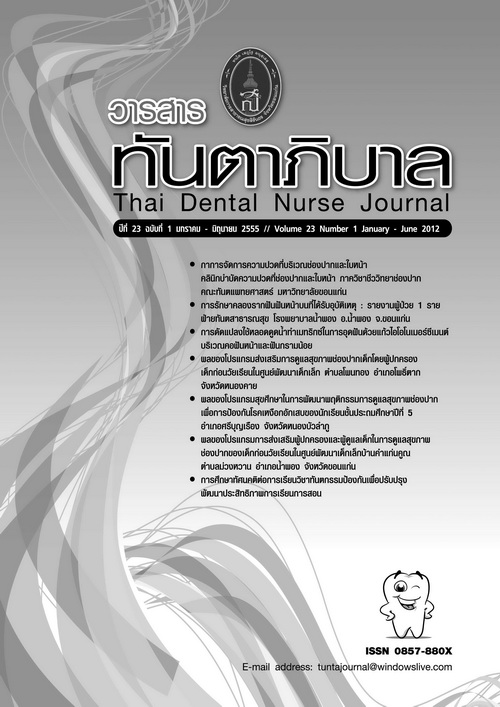การดัดแปลงใช้หลอดดูดน้ำทำเมทริกซ์ในการอุดฟันด้วยกลาสไอโอโนเมอร์ซีเมนต์บริเวณคอฟันหน้าและฟันกรามน้อย
คำสำคัญ:
รอยโรคบริเวณคอฟัน, กลาสไอโอโนเมอร์ซีเมนต์, เมทริกซ์เฉพาะซี่บริเวณคอฟันบทคัดย่อ
รอยโรคบริเวณคอฟันทั้งที่เกิดจากการผุ การสึกบริเวณคอฟันซึ่งเป็น รอยโรคในกลุ่มที่ไม่ได้เกิดจากรอยผุ (Non-carious cervical lesions, NCCLs) ได้แก่ การสึกกร่อนจากสารเคมี (Erosion) การสึกจากการเสียดสี (Abrasion) และการสึกจากแรงเค้นบริเวณคอฟันมากกว่าปกติ (Abfraction) สามารถบูรณะด้วยวัสดุเรซินคอมโพสิต หรือกลาสไอโอโนเมอร์ซีเมนต์ การอุด ฟันด้วยแก้วไอโอโนเมอร์ซีเมนต์ไม่เป็นที่นิยม เพราะวัสดุมักจะติดเครื่องมือ และการปั้นแต่งรูปร่างได้ยาก บทความนี้จะกล่าวถึง เทคนิคการดัดแปลง หลอดดูดน้ำทำเมทริกซ์เฉพาะซี่ในการอุดฟันด้วยกลาสไอโอโนเมอร์ซีเมนต์ บริเวณคอฟันหน้าและฟันกรามน้อย ซึ่งรวมถึง วิธีการดัดแปลงเมทริกซ์ ข้อบ่งใช้ และข้อควรระวังในการใช้งาน
เอกสารอ้างอิง
1. Francisconi Fávaro Luciana, Scaffa Mendes Candia Polliana, Barros Rosa dos Santos Paes de Vivian, Coutinho Margareth, Francisconi Afonso Silveira Paulo. Glass ionomer cements and their role in the restoration of non-carious cervical. J Appl Oral Sci 2009;17(5):364-9.
2. Yap AU, Neo JC. Non-carious cervical tooth loss: part 2: Management. Dent Update 1995;22(9):364-8.
3. Franco EB, Benetti AR, Ishikiriama SK, Santiago SL, Lauris JR, Jorge MF, et al. 5-year clinical performance of resin composite versus resin modified glass-ionomer restorative system in non-carious cervical lesions. Oper Dent 2006;31(4):403-8.
4. van Dijken JW. Retention of a resin-modified glass-ionomer adhesive in non-carious cervical lesions: a 6-year follow-up. J Dent 2005;33(7):541-7.
5. Tyas MJ. Clinical performance of glass-ionomer cements. J Minim Interv Dent 2008; 1 (2):88-94ใ
6. Lohbauer Ulrich . Dental Glass Ionomer Cements as Permanent Filling Materials? Properties, Limitations and Future Trends. Materials 2010; 3:76-96.
7. Wiegand A, Buchalla W, Attin T. Review on fluoride-releasing restorative materials: Fluoride release and uptake characteristics, antibacterial activity and influence on caries formation. Dent Mater 2007;23:343-62.
8. Francisconi LF, Honório HM, Rios D, Magalhães AC, Machado MAM, Buzalaf MAR. Effect of erosive pH cycling on different restorative materials and on enamel restored with these materials. Oper Dent 2008;33(2):203-8.
9. Mount JG. An atlas of Glass-Ionomer cements: A clinician’s guide. Type II.1: Restorative aesthetic cements. Second edition. Hong Kong: Imago Publishing Ltd.1994:p.42-61.
10. Albers F Harry. Tooth-colored restoratives: Principles and Techniques. Placement and Finishing. Ninth edition. Hamilton • London:BC Decker Inc. 2002:p.157-181.
11. Koprulu H, Gurgan S, Onen A. Marginal seal of a resin modified glass-ionomer restorative material: an investigation of placement techniques. Quintessence Int 1995; 26:729-732.
2. Yap AU, Neo JC. Non-carious cervical tooth loss: part 2: Management. Dent Update 1995;22(9):364-8.
3. Franco EB, Benetti AR, Ishikiriama SK, Santiago SL, Lauris JR, Jorge MF, et al. 5-year clinical performance of resin composite versus resin modified glass-ionomer restorative system in non-carious cervical lesions. Oper Dent 2006;31(4):403-8.
4. van Dijken JW. Retention of a resin-modified glass-ionomer adhesive in non-carious cervical lesions: a 6-year follow-up. J Dent 2005;33(7):541-7.
5. Tyas MJ. Clinical performance of glass-ionomer cements. J Minim Interv Dent 2008; 1 (2):88-94ใ
6. Lohbauer Ulrich . Dental Glass Ionomer Cements as Permanent Filling Materials? Properties, Limitations and Future Trends. Materials 2010; 3:76-96.
7. Wiegand A, Buchalla W, Attin T. Review on fluoride-releasing restorative materials: Fluoride release and uptake characteristics, antibacterial activity and influence on caries formation. Dent Mater 2007;23:343-62.
8. Francisconi LF, Honório HM, Rios D, Magalhães AC, Machado MAM, Buzalaf MAR. Effect of erosive pH cycling on different restorative materials and on enamel restored with these materials. Oper Dent 2008;33(2):203-8.
9. Mount JG. An atlas of Glass-Ionomer cements: A clinician’s guide. Type II.1: Restorative aesthetic cements. Second edition. Hong Kong: Imago Publishing Ltd.1994:p.42-61.
10. Albers F Harry. Tooth-colored restoratives: Principles and Techniques. Placement and Finishing. Ninth edition. Hamilton • London:BC Decker Inc. 2002:p.157-181.
11. Koprulu H, Gurgan S, Onen A. Marginal seal of a resin modified glass-ionomer restorative material: an investigation of placement techniques. Quintessence Int 1995; 26:729-732.
ดาวน์โหลด
ฉบับ
ประเภทบทความ
บทวิทยาการคลินิก (Clinical science article)
สัญญาอนุญาต
บทความที่ได้รับการตีพิมพ์ถือเป็นลิขสิทธิ์ของวารสารทันตาภิบาล





